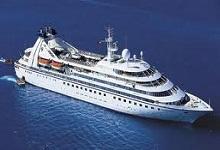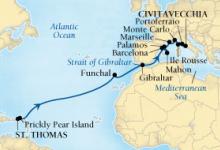Recently Viewed Cruises
- Legend, Transatlantic & Tuscan Spring ex Charlotte Amalie to RomeAdd to favourites
- Legend, Atlantic & Tuscan Jewels ex Charlotte Amalie to NiceAdd to favourites
- Mariner, Circle the Mediterranean ex Barcelona to VeniceAdd to favourites
- Quest, Spring & The Arts along Cote d'azur ex Barcelona to Monte CarloAdd to favourites
- Columbus 2, Between Orient and Occident ex Dubai to Monte CarloAdd to favourites
- Royal Caribbean International raises the bar
- Classy Astor fills gap in market
- Oceanic Discoverer
- Ab Fab Oosterdam
- Catch up on Cruising: Latest cruise news in bite size
- Frequently Asked Questions
-
Legend, Transatlantic & Tuscan Spring ex Charlotte Amalie to Rome
Nights 22 Ship Seabourn Legend Star Rating 
Departs Charlotte Amalie, U.S. Virgin Islands Sailing 2013: 6 Apr Ports of Call Charlotte Amalie, Prickly Pear Island, Funchal (Madeira), Gibraltar, Barcelona, Mahon, Palamos, Marseilles More Monte Carlo, L'Ile-Rousse, Portoferraio, Rome (Civitavecchia) Please enquire about this cruise for pricing.


22 Night Cruise sailing from Charlotte Amalie to Rome aboard Seabourn Legend.
Seabourn acquired its third intimate ship in 1996. Seabourn Legend, like its sisters, was built in Bremerhaven, Germany at the Schichau Seebeckwerft shipyard.
Originally launched as Royal Viking Queen for the prestigious Royal Viking Line, Seabourn Legend was re-christened by Linn Brynestad, Seabourn founder Atle Brynestad's wife.
Along with their all-suite accommodations and renowned personalized service, Seabourn's ships also garner consistent acclaim for the award-winning dining on board. Under the expert guidance of celebrity chef Charlie Palmer, Seabourn ships deliver superb cuisine that rivals the finest restaurants anywhere. From French fries to foie gras, every dish receives the expert attention of highly skilled and imaginative chefs. The finest ingredients are selected with care, perfectly prepared to your order, and served with pride. The Restaurant serves breakfast, lunch and dinner in an open-seating style that invites guests to dine where, when and with whom they choose.
The Veranda Cafe is a more casual, indoor/outdoor venue serving lavish buffets for breakfast and luncheon. In the evening, the Veranda Cafe becomes Restaurant 2, alternately serving innovative tasting menus and regionally-themed dinners with table service. The Sky Grill, at the popular alfresco Sky Bar, hosts occasional themed luncheons, and dinners of grilled specialties under the stars. Festive Deck Barbecue dinners and signature Caviar in the Surf beach parties are highlights on many cruises. And guests are welcome to order from The Restaurant menu and have their dinners served, course by course, in their suites if they wish. There is never an extra charge for any dining on Seabourn.
Highlights of this itinerary:
Charlotte Amalie, St. Thomas U.S. Virgin Islands
Since the arrival of the first Europeans, led by Christopher Columbus in 1493, the Virgin Islands have had a varied and colorful history. The English, Dutch, Spanish, French and Danish have all had their influence on the development of the islands into a trading crossroads of the Atlantic. Charlotte Amalie is the hillside port town of St. Thomas and is famous for its shopping attractions. Many of the boutiques were once pirate strongholds or thick-walled arched-ceiling warehouses. Today, restored, they spill over with tempting imports. Non-shoppers will find beautiful beaches and water sport facilities to while away some sun filled hours.
Prickly Pear Island, British Virgin Islands
The lovely little island of Prickly Pear gets its name for its habitat that favors this cactus species. The island is situated in the North Sound of Virgin Gorda, which is generally considered to be the island Columbus named Saint Ursula. How and when Virgin Gorda became the "Fat Virgin," no one is certain. All land over 1,000 feet high on Virgin Gorda has been designated National Park, thus preserving its natural beauty. It is also known for long, exquisite white sand beaches, including several on Prickly Pear itself, which boasts some of the BVIs' loveliest. In 1964 Laurence Rockefeller built the island's first resort hotel at Little Dix Bay, and since then Virgin Gorda has continued to grow in popularity with visitors. Weather permitting the ship makes a brief stop off Spanish Town to disembark those guests going on tour. It then repositions to anchor off Prickly Pear where the crew gets set up to treat you to a complimentary Prickly Pear beach party. A tender picks up all guests on tour at Leverick Bay to return them directly to Prickly Pear in time for this event.
Funchal
The Madeira Archipelago, consisting of the islands Madeira, Porto Santo and Desertas, is situated in the Atlantic, about 400 miles from the African coast and 560 miles from Lisbon. Discovered by the Portuguese in 1419, Madeira, the largest of the islands, became of great importance to Portugal for its sugar production and later on for the cultivation of wine. The unusually temperate oceanic climate and extraordinary scenery had Northern Europeans flocking to Madeira as early as the 18th century to spend the winter months. The winning combination of high, rocky peaks, steep green ravines and waterfalls in the interior, with the flowering charm of Funchal still attracts nearly half a million visitors each year.
Gibraltar, British Territory
With Spain to the north and Morocco to the south, Gibraltar is the famous promontory dominating the narrow entrance to the Mediterranean. Its position led to its seizure by the Moors in 711 as a prelude to the conquest of Spain. The Moorish influence includes the name Gibraltar, a corruption of "Jebel Tariq" (Tariq's Mountain), named after the Moorish commander Tariq who built the first fortification. In ancient times Gibraltar was regarded as one of the two Pillars of Hercules, which marked the western limits of the known world. Known commonly as "The Rock," Gibraltar is full of natural caves and manmade tunnels. The Rock itself, composed of limestone and gray marble, is geographically part of the Iberian Peninsula. Politically, the British have controlled Gibraltar for over two centuries. This tiny self-governing British Colony welcomes you to enjoy its historical sites, magnificent views, beautiful beaches and duty free shops.
Barcelona
Barcelona, the capital of Catalonia, is said to have been founded by the Phoenicians, and was once the rival of the powerful states of Venice and Genoa for control of the Mediterranean trade. Today, it is Spain's second largest city and has long rivaled, even surpassed Madrid in industry and commerce. The medieval atmosphere of the Gothic Quarter and the elegant boulevards combine to make the city one of Europe's most beautiful. Barcelona's active cultural life and heritage brought forth such greats as the architect Antonio Gaudi, the painter Joan Miro, and Pablo Picasso, who spent his formative years here. Other famous native Catalan artists include cellist Pau Casals, surrealist Salvador Dali, and opera singers Montserrat Caballe and Josep Carreras. Barcelona accomplished a long-cherished goal with the opportunity to host the Olympics in 1992. This big event prompted a massive building program and created a focal point of the world's attention.
Marseille (Provence), France
Marseilles, France's second-largest city after Paris, is an exciting, cosmopolitan port comprised of some sixteen distinct arrondissements, or neighborhoods. A large Algerian contingent calls the city home, adding its own inimitable accent. Much of the city's oldest section, Le Panier, was destroyed by German troops during World War II, sparing only three fine old edifices, including Hotel de Ville (City Hall). Two fortresses, St.-Jean and St.-Nicolas, guard the harbor entrance, while Marseilles's oldest church, Basilique St.-Victor, is virtually a fortress as well. This is a fine city for touring on foot, with sufficient cafes to provide refreshments along the way.
Monte Carlo, Monaco
The Principality of Monaco is the epitome of Riviera chic. This tiny enclave of 370 acres surrounds a sheltered harbor that draws yachts from around the world to enjoy the beautiful scenery, mild weather and elegant casino. Glamorous Monte Carlo is one of Monaco's four quarters, which also include La Condamine, the business district; Monaco-ville, the capital; and Fontvieille, an area built on reclaimed land. Ruled by Prince Albert II, Monaco has a population of over 32,000, of which about 16 percent are citizens, or Monegasques.
Civitavecchia (Rome), Italy
Originally built by Emperor Trajan who had a villa here, Civitavecchia has flourished as a major port for Rome since the 13th century. Today it is an important ferry terminal and for many travelers the gateway to the Eternal City, Rome. The Renaissance fortifications that surround the harbor area were begun by Bramante and completed by Michelangelo in 1535.





